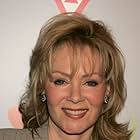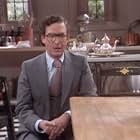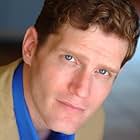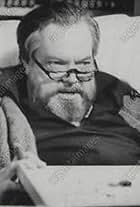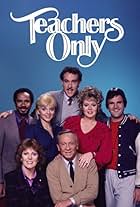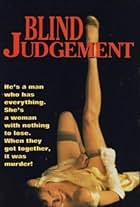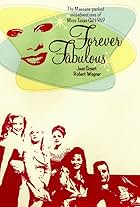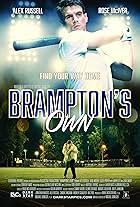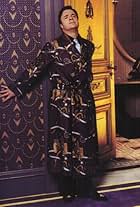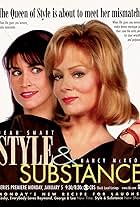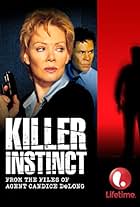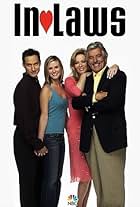Aggiungi una trama nella tua linguaCantankerous theatre critic Sheridan Whiteside falls on an icy sidewalk, breaks his hip, and is temporarily stranded at the Ohio home of Richard Stanley and his family. While he's there, Whi... Leggi tuttoCantankerous theatre critic Sheridan Whiteside falls on an icy sidewalk, breaks his hip, and is temporarily stranded at the Ohio home of Richard Stanley and his family. While he's there, Whiteside turns life upside-down for everyone.Cantankerous theatre critic Sheridan Whiteside falls on an icy sidewalk, breaks his hip, and is temporarily stranded at the Ohio home of Richard Stanley and his family. While he's there, Whiteside turns life upside-down for everyone.
Harriet Sansom Harris
- Maggie Cutler
- (as Harriet Harris)
Jeff Hayenga
- John
- (as Jeffrey Hayenga)
Trama
Lo sapevi?
- QuizThe original Broadway production of "The Man Who Came to Dinner" by Moss Hart and George S. Kaufman opened at the Music Box Theater on October 16, 1939 and ran for 739 performances.
However, given Whiteside's conversation with Walt Disney, it is clear this is not the script from opening night as Fantasia (1940), the project for which Disney provides consolation, did not premiere until one year after the play opened.
- Citazioni
Sheridan Whiteside: I may vomit.
- ConnessioniReferenced in My Boys: Free Agent (2006)
Recensione in evidenza
The 1942 film THE MAN WHO CAME TO DINNER was possibly the best comedy film that Bette Davis ever appeared in, but while she got starring position in the film's credits, the real star (who went to town as a result) was the great Monty Woolley, recreating his magnificent acid tongued curmudgeon Sheridan Whiteside. It was one of the rare occasions when a stage performance of importance was saved on film.
Fifty eight years later (forgetting one disastrous television version with Orson Welles as Whiteside in 1972) PBS showed this production of the stage revival of the play with Nathan Lane in the Whiteside role. Lane played the role perfectly, basing it (physically) closer to the original figure Whiteside is based on - writer, critic, actor, radio personality, and Algonquin Round Table Wit Alexander Woolcott. His facial appearance included wearing the round eye frame glasses that Woolcott wore all the time. Lane did not have the crusty, elderly asperity of the great Woolley, but he did have a malevolent elfin charm reminiscent of Woolcott (a man who was all too easy to dislike - Woolcott was also the model for Waldo Lydecker in LAURA, which just goes to show his popularity).
One of the problems with comedy (or drama generally speaking) is the fact that the works can be dated in their references. When, in one of his plays, Shakespeare refers to "the Great Sophy" it is to some long ago forgotten English traveler and diplomat named Shirley who went to Persia. Most of us see the foot note of this 16th Century reference and try to concentrate on the rest of the play that still is strong and relevant to us. But with THE MAN WHO CAME TO DINNER the great problem is the barrage of trivia that comes out of the play. Woolcott's two Algonquin friends (Kaufman and Moss Hart) added small bits of biography to his stage version, which everyone who knew Woolcott would recognize. The theater critic knew everyone of importance in the theater. So he has a scene with a clone of Noel Coward named Beverley Carlton (to add to perfecting the imitation of Coward, Kaufman and Hart asked Cole Porter, a close friend of Monty Woolley, to write a song for "Carlton" to sing to Whiteside, that was in Coward's distinct delicate style). The close friend of Whiteside who shows up as a comic "deus ex ma china" in the play is "Banjo." This was based on Woolcott's close Algonquin friend Harpo Marx.
But most of the references are quite arcane. Who is Elizabeth Sedley? Well, it is a reference to a celebrated murder case defendant, whose career would have intrigued Woolcott, the great amateur criminologist. What are the references to Beebe and Byrd? This version got around the problems using mock 1930s newspaper headlines chronicling William Beebe the oceanographer and Admiral Richard Byrd, the Polar explorer. This sounds cumbersome, but it was far more effective and useful to the viewers than the idiocy of the 1972 Welles' version where the script was "up-dated" meaninglessly.
The program was an excellent version of the classic comedy, and well worth comparing with the Woolley film. I feel that it deserves a "10".
Fifty eight years later (forgetting one disastrous television version with Orson Welles as Whiteside in 1972) PBS showed this production of the stage revival of the play with Nathan Lane in the Whiteside role. Lane played the role perfectly, basing it (physically) closer to the original figure Whiteside is based on - writer, critic, actor, radio personality, and Algonquin Round Table Wit Alexander Woolcott. His facial appearance included wearing the round eye frame glasses that Woolcott wore all the time. Lane did not have the crusty, elderly asperity of the great Woolley, but he did have a malevolent elfin charm reminiscent of Woolcott (a man who was all too easy to dislike - Woolcott was also the model for Waldo Lydecker in LAURA, which just goes to show his popularity).
One of the problems with comedy (or drama generally speaking) is the fact that the works can be dated in their references. When, in one of his plays, Shakespeare refers to "the Great Sophy" it is to some long ago forgotten English traveler and diplomat named Shirley who went to Persia. Most of us see the foot note of this 16th Century reference and try to concentrate on the rest of the play that still is strong and relevant to us. But with THE MAN WHO CAME TO DINNER the great problem is the barrage of trivia that comes out of the play. Woolcott's two Algonquin friends (Kaufman and Moss Hart) added small bits of biography to his stage version, which everyone who knew Woolcott would recognize. The theater critic knew everyone of importance in the theater. So he has a scene with a clone of Noel Coward named Beverley Carlton (to add to perfecting the imitation of Coward, Kaufman and Hart asked Cole Porter, a close friend of Monty Woolley, to write a song for "Carlton" to sing to Whiteside, that was in Coward's distinct delicate style). The close friend of Whiteside who shows up as a comic "deus ex ma china" in the play is "Banjo." This was based on Woolcott's close Algonquin friend Harpo Marx.
But most of the references are quite arcane. Who is Elizabeth Sedley? Well, it is a reference to a celebrated murder case defendant, whose career would have intrigued Woolcott, the great amateur criminologist. What are the references to Beebe and Byrd? This version got around the problems using mock 1930s newspaper headlines chronicling William Beebe the oceanographer and Admiral Richard Byrd, the Polar explorer. This sounds cumbersome, but it was far more effective and useful to the viewers than the idiocy of the 1972 Welles' version where the script was "up-dated" meaninglessly.
The program was an excellent version of the classic comedy, and well worth comparing with the Woolley film. I feel that it deserves a "10".
- theowinthrop
- 9 mar 2006
- Permalink
I più visti
Accedi per valutare e creare un elenco di titoli salvati per ottenere consigli personalizzati
Dettagli
Contribuisci a questa pagina
Suggerisci una modifica o aggiungi i contenuti mancanti

Divario superiore
What is the Spanish language plot outline for The Man Who Came to Dinner (2000)?
Rispondi








